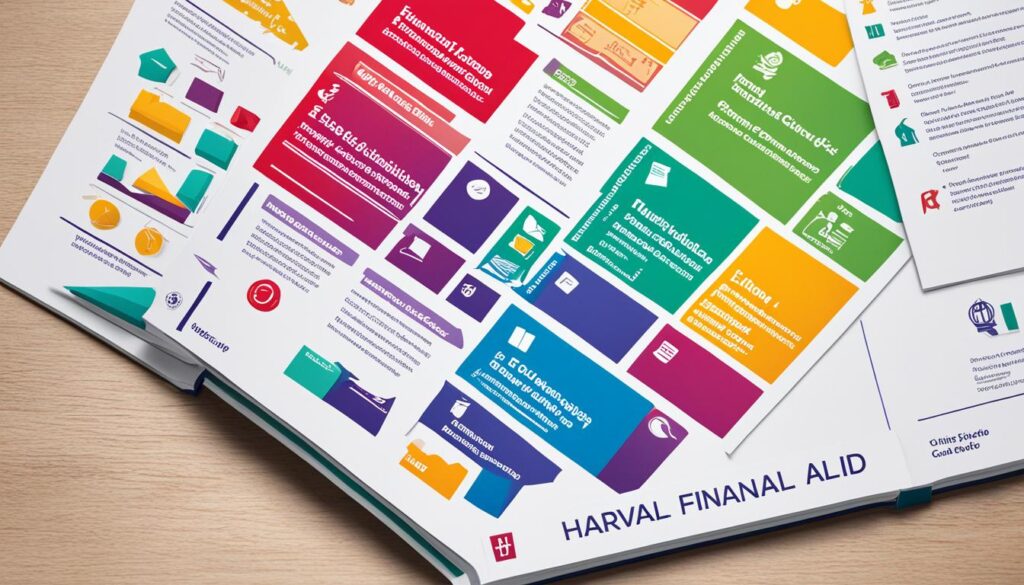It’s a common belief that Harvard University, one of the globe’s most prestigious institutions, is financially out of reach for those without significant scholarship aid. With the anxiety surrounding education expenses ever-present in the minds of potential college students and their families, you might be asking: How much does Harvard University cost without the aid of scholarships? It’s a crucial question that affects your planning college budget and shapes your academic future. Often, families dismiss Harvard as a plausible option due to perceived prohibitive costs associated with tuition fees without financial aid.
However, Harvard’s comprehensive financial aid program offers a silver lining, shattering the notion that this Ivy League education is exclusive to the wealthy. You might be surprised to learn that for many, the dream of attending Harvard can become a reality with a surprisingly affordable price tag, even for those who believe they stand outside the scholarship bracket.
Before you set your sights elsewhere due to financial worries, let’s delve into the actual costs and financial aid opportunities that make Harvard accessible to students from diverse economic backgrounds. You may find that the path to these hallowed halls is more attainable than it seems.
Key Takeaways
- Harvard’s financial aid program significantly reduces the burden of tuition fees without financial aid.
- Understanding the real cost of Harvard, beyond sticker shock, is vital in planning your college budget.
- A large portion of Harvard students receive considerable financial aid, making the university far more affordable.
- Income thresholds set by Harvard can result in no expected family contribution for low to middle-income families.
- International students enjoy the same financial aid privileges as American students, proving Harvard’s commitment to inclusivity.
- The need-blind admission policy ensures that your financial background does not affect your chances of acceptance.
Understanding the Real Cost of Attending Harvard University
When you think of Harvard, what comes to mind might be its formidable reputation as one of the premier institutions of higher education. However, the investment required to be a part of this esteemed university goes beyond just tuition. As you consider your future at Harvard, grasping the total cost of attendance—not just the headline tuition figures—is essential.
The Cost Beyond Tuition: Factoring In Additional Expenses
Harvard additional costs stretch across various necessities that complete your educational experience. These include room and board, books, personal expenses, and travel. For the academic cycle of 2023-2024, these additional expenses mean the estimated total cost of attendance fluctuates between $82,950 and $87,450. While these amounts might raise eyebrows, they serve as a useful starting point for your financial planning.
- Room and Board
- Books and Academic Supplies
- Personal Expenses
- Travel and Transportation
Comparing Sticker Price vs. Actual Expense
At first glance, the sticker price of attending Harvard could set your pulse racing. With the published tuition rate hovering around $54,269 annually, it’s no surprise that prospective students might feel daunted. However, the net price—what you actually pay after financial aid—is often significantly lower. Harvard’s dedication to providing financial aid means the gap between sticker price and net price can be considerable, allowing for an education that is accessible regardless of economic background.
The real out-of-pocket cost for many can be much less than the upfront figures suggest, thanks to grants, scholarships, and the university’s robust financial aid program. It is the net price that better reflects your financial commitment, and for many Harvard students, this figure truly shows how attainable attending this lauded institution can be.
How Harvard’s Financial Aid System Works
Embarking on your journey to Harvard University, you might wonder about the landscape of financial support that awaits. It’s paramount to grasp how Harvard’s financial aid system is designed to facilitate your educational aspirations. With the prowess of a need-blind admissions policy and the commitment to addressing 100% of demonstrated financial need, the university stands firmly as a beacon of opportunity.
Need-Blind Admissions: Ensuring Equal Opportunity
Imagine a world where your college prospects are not defined by your financial situation. At Harvard, this is a tangible reality. The university’s need-blind admissions policy is a cornerstone of its inclusive philosophy. It means that your talent and potential are the sole criteria for admission—your financial background remains inconspicuous during the selection process. This policy ensures that the most talented students worldwide have access to an unparalleled education, unrestricted by economic barriers.

Meeting 100% of Demonstrated Financial Need
Your acceptance letter signifies the beginning of a diligently curated financial aid journey. Once Harvard discerns your financial circumstances, a tailor-made aid package awaits to bridge the gap between your family’s contribution and the cost of attendance. The clarity of this system is encapsulated in Harvard’s pledge to meet 100% of your demonstrated financial need without considering home equity or retirement funds. This robust guarantee extends an even playing field, inviting a mosaic of scholars to thrive within Harvard’s historic walls.
What this means for you, as a prospective Harvard attendee, is empowerment. Financial challenges that might have seemed insurmountable are proficiently navigated by the university’s financial aid program, illuminating your path toward academic excellence with equitable opportunities. If your heart is set on the enriching environment that Harvard offers, rest assured that the gates stand wide open, guided by a financial aid system that champions diversity and inclusion.
The Breakdown of Harvard’s Cost Without Scholarship
When you’re eyeing Harvard University, understanding the financial investment is crucial, especially if you’re considering the path without scholarship aid. Harvard University tuition represents a premier education cost that is felt more acutely by families with higher incomes. If your family earns above $150,000 annually, it’s essential to prepare for substantial out-of-pocket expenses.

Let’s delve into the comprehensive cost breakdown and dissect the main components:
- Tuition: The core expense, Harvard’s tuition can reach tens of thousands each year, which might be the most significant part of your education costs.
- Additional Fees: These mandatory fees encompass various university services, adding a considerable sum to the tuition.
- Housing and Food: On-campus living and meal plans contribute to the convenience of college life but also to the expense.
- Health Insurance: An essential requirement unless you’re already covered, health insurance must be factored into your budget.
- Personal Expenses: From books to travel, these needs can vary significantly, influenced by lifestyle and academic requirements.
The price tag for these cumulative costs can extend up to $79,450, before any financial aid is applied. This figure doesn’t even include personal spending money or travel for the holidays. While the vision of joining the Harvard community is inspiring, it’s equally imperative to be pragmatic about the financial obligation that comes with it. Bear in mind, Harvard’s commitment to education extends to providing resources that can help manage and plan these expenses, yet the responsibility ultimately rests upon your shoulders to ensure your budget aligns with your academic goals.
A Closer Look at Harvard’s Tuition Fees and Living Costs
As you continue to weigh your collegiate options, it’s crucial to understand not only the academic benefits that Harvard University provides but also the financial commitments that accompany this prestigious institution. Beyond the headline figures, getting to grips with the nuanced details of Harvard’s on-campus living cost, the trend of annual tuition increase, and the estimated personal college expenses can provide a comprehensive view of what your investment will truly encapsulate.

Tuition Fees: Understanding the Annual Increase
Principal among the costs is tuition, which is apt to rise from year to year. Harvard has seen a consistent increase in tuition fees, reflecting several factors such as inflation and the university’s efforts to maintain exceptional educational standards and facilities. For the current academic year, tuition is set at $54,269. This figure forms the backbone of your educational investment and it serves as a critical base from which to calculate the complete costs of a Harvard education.
Accommodation and Boarding: Estimating On-Campus Housing Costs
- Residence Halls: $12,424 per year
- Meal Plan: $7,950 per year
Accommodation and boarding are central aspects of your on-campus experience and may vary depending on the choices you make. Living on the Harvard campus is an integral part of the college experience, and it comes with a predictable cost. At a current rate of $12,424 for on-campus housing and an additional $7,950 allocated towards dining, these fixed costs need to be included in your total expense calculations.
Additional Living Expenses: Books, Travel, and Personal Costs
- Books and Supplies: Approximately $1,000 per year
- Personal Expenses: Around $2,500 per year
- Travel: Can vary, potentially reaching upwards of $4,500 per year
Moreover, additional living expenses such as books, supplies, and personal expenditure are not to be overlooked. Estimated at approximately $1,000 annually for books and $2,500 for personal expenses, these contribute to the greater picture. Travel costs, although highly variable, are an equally essential consideration, especially for those coming from afar. They can significantly impact your estimated personal college expenses, rounding off the full scope of what attending Harvard truly entails.
These comprehensive cost elements define the financial landscape of a Harvard education. It’s important to anticipate and prepare for them—beyond just the tuition fees—as they complete the true cost of your college journey. Reflect on this information as you plan, knowing that your time at Harvard is not only an academic investment but also a financial one that demands careful consideration and forward planning.
The Continents States University: An Affordable Alternative
As you navigate the landscape of higher education, you may find The Continents States University emerging as a compelling beacon of affordable education. This institution, fully accredited in the United States and proudly based in Missouri, breaks away from traditional educational molds by offering a unique learning approach that prioritizes your needs and preferences.
No Exams, No Live Lectures: A Unique Approach to Education
Imagine engaging in a learning experience where the typical pressures of exams and scheduled live lectures do not dictate the pace of your education. This is the reality at The Continents States University. Its innovative educational model is designed to accommodate a broad spectrum of student lifestyles, enabling you to learn in a way that’s more attuned to your personal rhythm.
- Flexibility in learning methods, catering to different time zones and schedules
- Adaptable educational content that resonates with varied learning styles
- Stress-free environment devoid of traditional exams and mandatory live sessions
This focus on a unique learning approach not only serves to reduce the usual stress associated with stringent academic requirements but also opens doors for a wider, more diverse student population. If you’re seeking a cost-effective way to achieve your higher education goals, The Continents States University offers you an opportunity to do so without the financial strain often encountered elsewhere.

Exploring Financial Options Beyond Harvard Scholarships
Understanding that not everyone will be covered by Harvard’s comprehensive scholarship program, it’s imperative to explore a myriad of financial aid alternatives available to support your educational journey. Delving beyond the common avenues, you will find a variety of options to consider that could significantly reduce the financial burden of a prestigious education.
Employment Opportunities for Students at Harvard
Embrace the opportunity to work while you study through Harvard’s numerous student employment options. Earning money while gaining valuable experience, Harvard students find themselves well-positioned to manage their education expenses effectively. With the recent reduction in summer work expectations, balancing work and study has never been easier.
- Administrative Assistants
- Research Aides
- Library Attendants
- IT Support Staff
External Grants and Private Scholarships
The quest for financial support does not end with the boundaries of campus. A vast array of external grants and private scholarships await your application. These forms of financial aid often go unclaimed, so ensuring you cast a wide net could result in additional funding to further alleviate your financial responsibilities.
- Research industry-specific scholarships
- Apply for community organization grants
- Seek out niche scholarship options that align with your background or interests
Optional Loan Programs
Although loans should be approached with caution, they remain a practical component of financial aid alternatives for some families. Harvard provides access to resources and information regarding optional loan programs, ensuring that you have the ability to make well-informed decisions as you plan the financing of your education.
- Federal Student Loans
- Private Loan Options
- Harvard Loan Programs for those who qualify
Demystifying the Cost of Attendance with Harvard’s Net Price Calculator
If the thought of calculating your college expenses is overwhelming, you’ll find solace in a comprehensive financial planning tool Harvard provides—the Net Price Calculator. This intuitive resource is designed to give you and your family an accurate assessment of your estimated family contribution. By factoring in various financial details such as your family’s income and assets, this calculator simplifies the discovery of what Harvard could actually cost you.
With the Net Price Calculator, you can unveil the mystery behind financial aid packages. The calculator is more than just a mere estimator; it’s your personal financial planning tool. Guided by inputs personalized to your family’s financial situation, the calculator projects an aid package tailored to your needs. What’s more, it gives you a tangible framework for budgeting and preparing for your educational journey.
- Enter your financial information to gauge the estimated family contribution.
- Review the breakdown of the various costs you might incur, from tuition to room and board.
- Receive an estimate of the financial aid package you may be eligible for, which can significantly lower the net price of attending Harvard.
Discovering your prospective net price is a crucial step in securing your academic future without undue financial stress. Make use of Harvard’s Net Price Calculator today, and take the first confident step toward realizing your higher education goals.
Revealing the Full Cost of a Harvard Education
As you consider the journey to Harvard University, understanding the complete Harvard education cost is paramount. A comprehensive educational investment doesn’t merely cover the direct expenses such as tuition—it encompasses a gamut of costs that add up over an academic year. Let’s dissect these particulars to shed light on the true financial commitment you’ll be making when you aim for a Harvard diploma without the adjustments of financial aid.
What does a comprehensive educational investment look like? First, you need to account for the billed expenses: tuition itself, housing, and service fees such as health services and access to facilities. Then, there are the unbilled costs—personal expenses, books, supplies, and travel to and from campus. All these are integral to the Harvard experience and vital elements of the total educational expenditure. However, amidst these facts, don’t lose sight of the financial aid facts provided by Harvard, which can significantly alleviate the financial burden for eligible students.
Harvard’s financial aid office is dedicated to making this a feasible investment. Their promise to meet 100% of demonstrated financial need is not just a statement but a steadfast mission in action. The substantial financial aid packages they offer are designed to ensure that Harvard is accessible to the most promising and talented minds, irrespective of their economic circumstances.
- Billed expenses, including tuition, can be offset by Harvard’s financial aid offerings
- Unbilled expenses should be factored into your overall budget
- Comprehensive educational investment includes the hidden cost of opportunity
If your family resources are high, the investment might be heftier. Yet, this should not deter you; rather, it’s an invitation to uncover the wide-ranging support Harvard provides. The complete Harvard education cost, thus, becomes not just an expense but an investment in your future—and Harvard’s extensive financial aid is there to ensure it’s an investment within reach.
Conclusion
As you assess the myriad of factors contributing to the decision of where to pursue higher education, Harvard University stands out not just for its academic excellence but also for its dedication to making this exceptional education attainable regardless of economic background. Through proactive financial planning and the university’s pledge to affordability, the dream of walking through Harvard’s storied gates is a realistic ambition for students from all walks of life.
Harvard’s Commitment to Affordability and Access
Harvard’s philosophy on educational accessibility materializes in its comprehensive financial aid program, designed to extricate the burden of cost from the equation of college opportunity. This equitable approach reiterates the institution’s mission to cultivate an environment where the only currency of value is merit, not monetary capability. Your ambitions are validated here, with a promise that your financial situation will never undercut your academic potential.
Empowering Prospective Students: Calculating Your Investment in Education
Your journey to deciding on Harvard is bolstered by harvard affordability tools like the Net Price Calculator—an innovation that’s emblematic of Harvard’s transparency in guiding you through a clear understanding of your educational investment. With this at your fingertips, you’re empowered to plan with precision and confidence, knowing that you have access to resources that demystify costs and spotlight the tangible value of a Harvard education. It’s a proactive step that harmonizes your aspirations with the financial realities of a world-class education.


